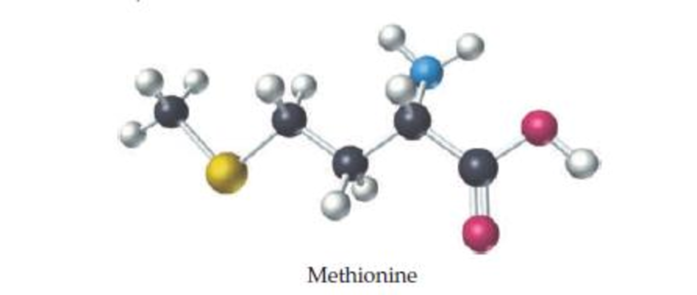
Methionine, an amino acid used by organisms to make proteins, can be represented by the following ball-and-stick molecular model. Write the formula for methionine, and give its molecular weight (red = O, black = C, blue = N, yellow = S, white = H).

Interpretation:
The formula and molecular weight for methionine and should be determined by using the given ball- and- stick molecular model.
Concept Introduction:
Molecular Formula: It is the simplest representation of composition of chemical substance where each and every type of atom is written with the total number of the atom present in the substance.
Molecular weight: The sum of mass of all atoms present in formula of chemical substance is referred as molecular or formula weight of that substance.
Answer to Problem 6.15UKC
The empirical formula for the given structure is
The molecular weight of
Explanation of Solution
Comparing the given details such as red color indicates
The molecular weight for
Finally, molecular weight is obtained by adding
The molecular formula for methionine and molecular weight is determined by using the given ball- and- stick molecular model with details.
Want to see more full solutions like this?
Chapter 6 Solutions
EBK FUNDAMENTALS OF GENERAL, ORGANIC, A
- Background Freezing isn't the only challenge in cryopreservation - thawing can be just as difficult. A microwave oven seems like a nice solution, since it deposits energy quickly and microwaves are non-ionizing radiation (they do not cause DNA mutation). However, water absorbs microwaves more effectively than ice does, meaning that the portion of an organ that has already melted will get warmer at a higher rate than the remaining ice – the opposite of what we want! - The transmission of radiation through a weakly absorbing material such as ice or water can be modeled by Beer's law, which assumes that the rate of absorption at a depth x is proportional to the local radiation intensity I(x) times an absorption coefficient, which is often written as μ or a or just µ). Noting that absorption decreases the intensity, we can write a differential equation a Solving the differential equation with the boundary condition on the surface being gives the relationship For a standard microwave oven…arrow_forward3. Dry air is inhaled at a rate of 10 liter/min through a trachea with a diameter of 20 mm and a length of 125 mm. The inner surface of the trachea is at a normal body temperature of 37°C and may be assumed to be saturated with water. a. Assuming steady, fully developed flow in the trachea, estimate the mass transfer convection coefficient. b. Estimate the daily water loss (liter/day) associated with evaporation in the trachea.arrow_forward1. Conceptual questions a. What dimensionless group describes the relative importance of convection versus diffusion. Explain the physical basis of this group. b. For mass transfer from a flowing fluid to a reactive surface, explain how convection increases the flux of solute to the surface.arrow_forward
- Assessment +1501 pts /1600 Resources Solution ? Hint Sub bo Each pictured Lewis structure is invalid. Identify the error in each case. O Macmillan Learning :0▬▬0: Answer Bank wrong electron total :0- :F======F: octet-rule violation N :0:arrow_forward[s] mM V (M/s) Uninhibited 0.333 1.65 x 107 1.05 x 107 V (M/s) x 10' Inhibitor A V (M/s) x 107 Inhibitor B 0.794 x 107 0.40 1.86 x 107 1.21 x 107 0.893 x 107 0.50 2.13 x 107 1.43 x 107 1.02 x 107 0.666 2.49 x 107 1.74 x 107 1.19 x 107 1.0 2.99 x 107 2.22 x 107 1.43 x 107 2.0 3.72 x 107 3.08 x 107 1.79 x 107arrow_forwardFor a Michaelis-Menten reaction, k₁-5 x 10'/M-s, k.-2 x 10%/s, and k₂-4 x 10²/s. a) Calculate the Ks and KM for this reaction. b) Does substrate binding achieve equilibrium or steady state?arrow_forward
- Assume that an enzyme-catalyzed reaction follows the scheme shown: E+S SES →E + P k₁ = 1 x 109/M-s k-1=2.5 x 10%/s k₂ = 3.4 x 107/s What is the dissociation constant for the enzyme-substrate, K,? What is the Michaelis constant, Km, for this enzyme? What is the turnover number, Keat, for this enzyme? What is the catalytic efficiency for the enzyme? If the initial Et concentration is 0.25mM, what is Vmax?arrow_forwardAn enzyme lowers the activation energy, (AG) of a reaction from 50.0 kcal/mol to 40.0 kcal/mol. Calulate the catalytic power at 310K. (R-1.987x10 kcal/mol)arrow_forwardDraw a typical axodendritic synapse, including a specific neurotransmitter of your choice, its associated postsynaptic receptors (indicating whether they are ionotropic or metabotropic), and any associated reuptake transporters or degradation enzymes. Please include a description of what specific steps would occur as an action potential reaches the axonal terminal.arrow_forward
- Give a full arrow pushing mechanism of the spontaneous redox reaction between NAD+/NADH and oxaloacetate/malate. Please include diagram drawing of the mechanism! (Thank You!)arrow_forward18. Which one of the compounds below is the major organic product obtained from the following series of reactions? 1. BH3 2. H2O2, NaOH H₂CrO4 CH2N2 oro ororos A B C D Earrow_forward17. Which one of the compounds below is the major organic product obtained from the following series of reactions? CI benzyl alcohol OH PBr3 Mg 1. CO2 SOCl2 ? ether 2. H+, H₂O CI Cl HO OH CI Cl A B C D Earrow_forward
 Biology (MindTap Course List)BiologyISBN:9781337392938Author:Eldra Solomon, Charles Martin, Diana W. Martin, Linda R. BergPublisher:Cengage Learning
Biology (MindTap Course List)BiologyISBN:9781337392938Author:Eldra Solomon, Charles Martin, Diana W. Martin, Linda R. BergPublisher:Cengage Learning Principles Of Radiographic Imaging: An Art And A ...Health & NutritionISBN:9781337711067Author:Richard R. Carlton, Arlene M. Adler, Vesna BalacPublisher:Cengage Learning
Principles Of Radiographic Imaging: An Art And A ...Health & NutritionISBN:9781337711067Author:Richard R. Carlton, Arlene M. Adler, Vesna BalacPublisher:Cengage Learning Anatomy & PhysiologyBiologyISBN:9781938168130Author:Kelly A. Young, James A. Wise, Peter DeSaix, Dean H. Kruse, Brandon Poe, Eddie Johnson, Jody E. Johnson, Oksana Korol, J. Gordon Betts, Mark WomblePublisher:OpenStax College
Anatomy & PhysiologyBiologyISBN:9781938168130Author:Kelly A. Young, James A. Wise, Peter DeSaix, Dean H. Kruse, Brandon Poe, Eddie Johnson, Jody E. Johnson, Oksana Korol, J. Gordon Betts, Mark WomblePublisher:OpenStax College





